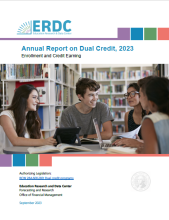Dual credit courses give high school students the potential to earn both college and high school credit. There are six primary dual credit programs in Washington state that were included in this report. This report and the accompanying dashboard examine dual credit enrollment and K-12 credit earned.
It is important to note that access to different types of dual credit courses varies across Washington state and that schools with high rates of low-income and students of color have more limited access, which may impact enrollment rates. For College Preparatory Programs with Exams (CPPE) dual credit courses, a student must opt to take an exam, get a specific score on the exam to be eligible to earn postsecondary credit, and matriculate at a university or community college that accepts the credit. The different enrollment criteria for each dual credit type and varied access to these opportunities across Washington state must be considered when interpreting the results of this report.
This report has two primary sections. First, we introduce new analysis related to dual credit in Washington. Then, we address the recommendations from the 2022 ERDC Dual Credit Report.
Key Findings include:
- 88% of students enrolled in at least one dual credit course and the majority enrolled in more than one type before exiting high school. As the total student population has increased over time, the rate of enrollment in dual credit has been maintained or increased for all dual credit types since the 2015 cohort. College in the High School experienced the largest increase.
- Four of the six dual credit types experienced nearly continual growth in the average total K-12 credits earned per student over time. However, students identified as low income, multilingual learners, or experiencing homelessness as well as those participating in migrant education, special education, or a 504 plan continue to earn fewer K-12 credits across all dual credit course types.
- The collection of detailed race and ethnicity data in K-12 allows for deeper exploration of student identities beyond the required federal race categories. There are differences in the dual credit enrollment experience of students who identify as American Indian/Alaska Native (AI/AN) only, students who identify as AI/AN and Hispanic, and students who identify as AI/AN and another race. This highlights a limitation of identifying students only using the federal categories.
- Regression analysis found that past educational achievement and student circumstances drive some of the racial differences seen in dual credit enrollment, indicating areas of focus for future policy changes.
- Data availability and quality continue to limit research on dual credit enrollment and earning of postsecondary credits.


